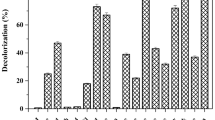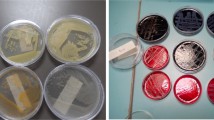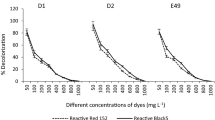Abstract
Synthetic dyes are established colorants in the pharmaceutical industries for the coating and coloration of tablets, capsules, etc. to mark the specific formulation and dosage, improve the stability, and esthetic value. The pharmaceuticals manufacturing process releases large volumes of dye-containing wastewaters, contributing to eco-toxic concerns related to different health risks. In this study, biodegradation of amaranth, sunset yellow, tartrazine, indigo carmine, and quinoline yellow dyes was investigated in the mixed environment. Initially, 24 tolerant bacterial strains were isolated from pharmaceutical wastewater samples, among which 19 strains were found to be non-virulent. Five different consortia were constructed by considering the 19 strains among which C1 consisting of strains DY7, 10, 11, and 18 was found to be the most potential consortium with an overall efficiency of 96.65% dye degradation in the presence of glucose after 15 days. The strains DY7, 10, 11, and 18 were identified as members of the Klebsiella genus by 16S rRNA partial sequencing. The cell wall structure, carbohydrate utilization profile, and metabolic characterization were conducted on the selected strains of C1. Among the 25 different antibiotics, DY7 and DY11 exhibited the highest zone of growth inhibition in the presence of cefixime, and DY10 was restricted by chloramphenicol whereas DY18 was found sensitive to ceftazidime/tazobactam.




Similar content being viewed by others
Data availability
The datasets used and/or analyzed during the current study are available from the corresponding author on reasonable request.
References
Abd-El-Malek AM (2017) Incidence and virulence characteristics of Aeromonas spp. in fish. Vet World 10:34–37. https://doi.org/10.14202/vetworld.2017.34-37
Aissaoui S, Ouled-Haddar H, Sifour M, Beggah C, Benhamada F (2017) Biological removal of the mixed pharmaceuticals: diclofenac, ibuprofen, and sulfamethoxazole using a bacterial consortium. Iran J Biotechnol 15:135–142. https://doi.org/10.15171/ijb.1530.
Amankwaah D, Cobbina SJ, Tiwaa YA, Bakobie N, Millicent EAB (2014) Assessment of pond effluent effect on water quality of Asuofia Stream, Ghana. Afr J Environ Sci Technol 8:306–311. https://doi.org/10.5897/AJEST2014.1665
Amchova P, Kotolova H, Ruda-Kucerova J (2015) Health safety issues of synthetic food colorants. Regul Toxicol Pharmacol 73:914–922. https://doi.org/10.1016/j.yrtph.2015.09.026
Baratéla KC, Saridakis HO, Gaziri LCJ, Pelayo JS (2001) Effects of medium composition, calcium, iron and oxygen on haemolysin production by Plesiomonas shigelloides isolated from water. J Appl Microbiol 90:482–487. https://doi.org/10.1046/j.1365-2672.2001.01270.x
Bessa VS, Moreira IS, Tiritan ME, Castro PML (2017) Enrichment of bacterial strains for the biodegradation of diclofenac and carbamazepine from activated sludge. Int Biodeterior Biodegradation 120:135–142. https://doi.org/10.1016/j.ibiod.2017.02.008
Boyd CE (2016) The complex principles of redox measurement. Global aquaculture advocate. https://www.aquaculturealliance.org/advocate/the-complex-principles-of-redox-measurement/?headlessPrint=AAAAAPIA9c8r7gs82oWZBA. Accessed on 9th July 2021.
Cheeseman M (2014) Food additives and packaging. In: Komolprasert V, Turowski P (eds) ACS Symposium Series, American Chemical Society, Washington, DC, Volume 1162, pp 3–9. https://doi.org/10.1021/bk-2014-1162.
Chopra S, Kumar D (2020a) Characterization, optimization and kinetic study of diclofenac degradation by novel bacterial strains and their synthetic consortia. Bioremediat J 24:150–170. https://doi.org/10.1080/10889868.2020.1793723
Chopra S, Kumar D (2020b) Biodegradation and kinetic analysis of acetaminophen with co-culture of bacterial strains isolated from sewage wastewater. Curr Microbiol 77:3147–3157. https://doi.org/10.1007/s00284-020-02137-6
Chowdhury MF, Khandaker S, Sarker F, Islam A, Rahman MT, Awual MR (2020) Current treatment technologies and mechanisms for removal of indigo carmine dyes from wastewater: a review. J Mol Liq e114061. https://doi.org/10.1016/j.molliq.2020.114061
Cimpan M (2013) Colour management for formulators. Colorcon. https://www.pharmaexcipients.com/wp-content/uploads/attachments/Colours-in-Pharmaceutical-products-printout-MC.pdf?t=1463001681
Confer AW, Ayalew S (2013) The OmpA family of proteins: roles in bacterial pathogenesis and immunity. Vet Microbiol 163:207–222. https://doi.org/10.1016/j.vetmic.2012.08.019
Cui D, Li G, Zhao D, Gu X, Wang C, Zhao M (2012) Microbial community structures in mixed bacterial consortia for azo dye treatment under aerobic and anaerobic conditions. J Hazard Mater 221:185–192. https://doi.org/10.1016/j.jhazmat.2012.04.032
Deng FC, Wang C, Gu W, Chen YY, Han JJ, Du HM, Peng H, Tang S (2020) Research advances in the adverse effects of azo dyes. Chin J Prev Med 54:1478–1483. https://doi.org/10.3760/cma.j.cn112150-20200114-00020
Edberg SC, Gallo P, Kontnick C (1996) Analysis of the virulence characteristics of bacteria isolated from bottled, water cooler, and tap water. Microb Ecol Health Dis 9:67–77. https://doi.org/10.3109/08910609609166445
Fawzi Suleiman Khasawneh O, Palaniandy P (2021) Removal of organic pollutants from water by Fe2O3/TiO2 based photocatalytic degradation: a review. Environ Technol Innov 21:e101230. https://doi.org/10.1016/j.eti.2020.101230
Goldfine H (2020) Participation of bacterial lipases, sphingomyelinases, and phospholipases in gram-positive bacterial pathogenesis. In: Goldfine H (ed) Health consequences of microbial interactions with hydrocarbons, oils, and lipids, Springer, Cham, pp 205–221. https://doi.org/10.1007/978-3-030-15147-8.
Grandclément C, Seyssiecq I, Piram A, Wong-Wah- Chung P, Vanot G, Tiliacos N, Roche N, Doumenq P (2017) From the conventional biological wastewater treatment to hybrid processes, the evaluation of organic micropollutant removal: a review. Water Res 111:297–317. https://doi.org/10.1016/j.watres.2017.01.005
Hu C, Xiong N, Zhang Y, Rayner S, Chen S (2012) Functional characterization of lipase in the pathogenesis of Staphylococcus aureus. Biochem Biophys Res Commun 419:617–620. https://doi.org/10.1016/j.bbrc.2012.02.057
Klein EJ, Stapp JR, Neill MA, Besser JM, Osterholm MT, Tarr PI (2004) Shiga toxin antigen detection should not replace sorbitol MacConkey agar screening of stool specimens. J Clin Microbiol 42:4416–4417. https://doi.org/10.1128/JCM.42.9.4416-4417.2004
König J (2015) Food colour additives of synthetic origin. In: Scotter MJ (ed) Colour additives for foods and beverages, Woodhead Publishing, pp 35–60. https://doi.org/10.1016/B978-1-78242-011-8.00002-7
Lenchenko E, Blumenkrants D, Sachivkina N, Shadrova N, Ibragimova A (2020) Morphological and adhesive properties of Klebsiella pneumoniae biofilms. Vet World 13:197–200. https://doi.org/10.14202/vetworld.2020.197-200.
Li HX, Xu B, Tang L, Zhang JH, Mao ZG (2015) Reductive decolorization of indigo carmine dye with Bacillus sp. MZS10. Int Biodeterior Biodegradation 103:30–37. https://doi.org/10.1016/j.ibiod.2015.04.007
Maity S, Biswas R, Sarkar A (2020) Comparative valuation of groundwater quality parameters in Bhojpur,. Chemosphere 259:e127398. https://doi.org/10.1016/j.chemosphere.2020.127398
McCoy LK (2005) Look-alike, sound-alike drugs review: include look-alike packaging as an additional safety check. Jt Comm J Qual Patient Saf 31:47–53. https://doi.org/10.1016/S1553-7250(05)31007-5
Metwally MA, Ali S, Khatab I, El-Sayed MK (2020). Antibacterial potential of some seaweeds species to combat biofilm-producing multi-drug resistant Staphylococcus aureus of Nile Tilapia. Egypt J Bot 60:9–24. https://doi.org/10.21608/ejbo.2019.6829.1275
Misba L, Zaidi S, Khan AU (2017) A comparison of antibacterial and antibiofilm efficacy of phenothiazinium dyes between gram positive and gram negative bacterial biofilm. Photodiagnosis Photodyn Ther 18:24–33. https://doi.org/10.1016/j.pdpdt.2017.01.177
Mohini G, Ekhalak A, Ranjana S (2014) Water quality of village pond for aquaculture development. In: Mishra GC (ed) Environmental sustainability:concepts, principles, evidences and innovations. Excellent Publishing House, New Delhi, India, pp 44–51
Neela V, Thomas R, Rankouhi SZR, Karunanidhi A, Shueh CS, Hamat RA, van Belkum A (2012) Modified DNase tube test to detect DNase activity in Stenotrophomonas maltophilia. J Med Microbiol 61:1792–1794. https://doi.org/10.1099/jmm.0.049403-0
Noori S, Ahmadyasbchin S (2020) Study of microbial decolorization of indigo carmine dye by Bacillus albus. J Ilam Uni Med Sci 28:29–39
Padhan B, Poddar K, Sarkar D, Sarkar A (2021) Production, purification, and process optimization of intracellular pigment from novel psychrotolerant Paenibacillus sp. BPW19. Biotechnol Rep 29:e00592. https://doi.org/10.1016/j.btre.2021.e00592
Phugare SS, Kalyani DC, Patil AV, Jadhav JP (2011) Textile dye degradation by bacterial consortium and subsequent toxicological analysis of dye and dye metabolites using cytotoxicity, genotoxicity and oxidative stress studies. J Hazard Mater 186:713–723. https://doi.org/10.1016/j.jhazmat.2010.11.049
Poddar K, Padhan B, Sarkar D, Sarkar A (2021) Purification and optimization of pink pigment produced by newly isolated bacterial strain Enterobacter sp. PWN1. SN Appl Sci 3:1–11. https://doi.org/10.1007/s42452-021-04146-x
Poddar K, Sarkar D, Sarkar A (2019) Construction of potential bacterial consortia for efficient hydrocarbon degradation. Int Biodeterior Biodegradation 144:e104770. https://doi.org/10.1016/j.ibiod.2019.104770
Poddar K, Sarkar A (2020) Emerging treatment strategies of pharmaceutical pollutants: Reactive physiochemical and innocuous biological approaches. In: Shah MP (ed) Removal of toxic pollutants through microbiological and tertiary treatment., Elsevier, pp 431–451. https://doi.org/10.1016/B978-0-12-821014-7.00017-4.
Ramsingh B (2010) The codex in historical perspective: food safety standards and the codex alimentarius commission (1962–1973). In: Seaton MB, Allin S (eds) Comparative program on health and society lupina foundation working papers series 2007–2009, MCIS BRIEFINGS, University of Toronto, pp 98–130
Rajashekar KK, Mahadevan GD, Neelagund SE, Sathynarayana M, Vijaya D, Mulla SI (2021) Decolorization of amaranth RI and fast red E azo dyes by thermophilic Geobacillus thermoleovorans KNG 112. J Chem Technol Biotechnol. https://doi.org/10.1002/jctb.6834
Ramesh M, Muthuraman A (2018) Flavoring and coloring agents: health risks and potential problems. In: Grumezescu AM, Holban AM (eds) Natural and artificial flavoring agents and food dyes, Academic Press, pp 1–28. https://doi.org/10.1016/B978-0-12-811518-3.00001-6
Roberts J, Kumar A, Du J, Hepplewhite C, Ellis DJ, Christy AG, Beavis SG (2016) Pharmaceuticals and personal care products (PPCPs) in Australia’s largest inland sewage treatment plant, and its contribution to a major Australian river during high and low flow. Sci Total Environ 541:1625–1637. https://doi.org/10.1016/j.scitotenv.2015.03.145
Sarkar D, Nanda S, Poddar K, Sarkar A (2021) Isolation and characterization of an antibacterial compound producing Stenotrophomonas strain from sewage water, production optimization, and its antibiotic potential evaluation. Environ Qual Manag 1–21. https://doi.org/10.1002/tqem.21764
Sarkar D, Prajapati S, Poddar K, Sarkar A (2019) Production of ethanol by Enterobacter sp. EtK3 during fruit waste biotransformation. Int Biodeterior Biodegradation 145:e104795. https://doi.org/10.1016/j.ibiod.2019.104795
Sarwade VD (2020) Bio-catalytic action of Pseudomonas DL17 on environmental contaminant sunset yellow FCF. Int J Res Appl Sci Eng Technol (IJRASET) 8:1056–1064
Schmidt C, Berghahn E, Ilha V, Granada CE (2019) Biodegradation potential of Citrobacter cultures for the removal of amaranth and congo red azo dyes. Int J Environ Sci Te 16:6863–6872. https://doi.org/10.1007/s13762-019-02274-x
Sink T, House M (2013) Understanding water quality reports for your pond. Agrilife Extension Solutions, EWF-017:1–6
Šuleková M, Smrčová M, Hudák A, Heželová M, Fedorová M (2017) Organic colouring agents in the pharmaceutical industry. Folia Vet 61:32–46. https://doi.org/10.1515/fv-2017-0025
Tao W, Zhang XX, Zhao F, Huang K, Ma H, Wang Z, Ye L, Ren H (2016) High levels of antibiotic resistance genes and their correlations with bacterial community and mobile genetic elements in pharmaceutical wastewater treatment bioreactors. PLoS ONE 11:e0156854. https://doi.org/10.1371/journal.pone.0156854
Turista DDR, Puspitasari E (2019) The growth of Staphylococcus aureus in the blood agar plate media of sheep blood and human blood groups A, B, AB, and O. J Teknol 8:1–7. https://doi.org/10.29238/teknolabjournal.v8i1.155
Urmi AS, Inaba H, Nomura R, Yoshida S, Ohara N, Asai F, Nakano K, Matsumoto-Nakano M (2021) Roles of Porphyromonas gulae proteases in bacterial and host cell biology. Cell Microbiol 23:e13312. https://doi.org/10.1111/cmi.13312
WHO (2019) WHO calls for urgent action to reduce patient harm in healthcare. https://www.who.int/news/item/13-09-2019-who-calls-for-urgent-action-to-reduce-patient-harm-in-healthcare
Zahran SA, Ali-Tammam M, Hashem AM, Aziz RK, Ali AE (2019) Azoreductase activity of dye-decolorizing bacteria isolated from the human gut microbiota. Sci Rep 9:1–14. https://doi.org/10.1038/s41598-019-41894-8
Zhuang M, Sanganyado E, Zhang X, Xu L, Zhu J, Liu W, Song H (2020) Azo dye degrading bacteria tolerant to extreme conditions inhabit nearshore ecosystems: optimization and degradation pathways. J Environ Manage 261:e110222. https://doi.org/10.1016/j.jenvman.2020.110222
Acknowledgements
The authors express sincere gratitude towards Cadila Pharmaceuticals Limited, Gujarat, India for providing insights into the pharmaceutical industry and tablet manufacturing process. The authors are also thankful to the Central Instrumentation Facility of the National Institute of Technology Rourkela for providing suitable technical facilities.
Funding
The authors acknowledge the Department of Science and Technology, Government of India for providing the financial support in carrying out the research work (IMP/2018/000241).
Author information
Authors and Affiliations
Contributions
All authors have contributed to the construction of this manuscript. KP: Conceptualization, methodology, formal analysis, validation, and writing — original draft. DS: Data curation, writing — review and editing, and visualization. AS: Supervision and project administration.
Corresponding author
Ethics declarations
Ethics approval and consent to participate
The authors have no ambiguity in the submission of the experimental data from this work.
Consent for publication
All authors agreed to the publication of this manuscript in the journal “Environmental Science and Pollution Research”.
Competing interests
The authors declare no competing interests.
Additional information
Responsible Editor: Robert Duran
Publisher's note
Springer Nature remains neutral with regard to jurisdictional claims in published maps and institutional affiliations.
Supplementary Information
Below is the link to the electronic supplementary material.
Rights and permissions
About this article
Cite this article
Poddar, K., Sarkar, D. & Sarkar, A. Construction of bacterial consortium for efficient degradation of mixed pharmaceutical dyes. Environ Sci Pollut Res 30, 25226–25238 (2023). https://doi.org/10.1007/s11356-021-18217-4
Received:
Accepted:
Published:
Issue Date:
DOI: https://doi.org/10.1007/s11356-021-18217-4




